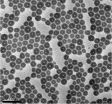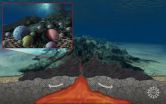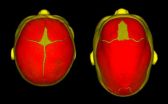(Press-News.org) HOUSTON -- (Nov. 19, 2012) -- Rice University scientists have unveiled a revolutionary new technology that uses nanoparticles to convert solar energy directly into steam. The new "solar steam" method from Rice's Laboratory for Nanophotonics (LANP) is so effective it can even produce steam from icy cold water.
Details of the solar steam method were published online today in ACS Nano. The technology has an overall energy efficiency of 24 percent. Photovoltaic solar panels, by comparison, typically have an overall energy efficiency around 15 percent. However, the inventors of solar steam said they expect the first uses of the new technology will not be for electricity generation but rather for sanitation and water purification in developing countries.
"This is about a lot more than electricity," said LANP Director Naomi Halas, the lead scientist on the project. "With this technology, we are beginning to think about solar thermal power in a completely different way."
The efficiency of solar steam is due to the light-capturing nanoparticles that convert sunlight into heat. When submerged in water and exposed to sunlight, the particles heat up so quickly they instantly vaporize water and create steam. Halas said the solar steam's overall energy efficiency can probably be increased as the technology is refined.
"We're going from heating water on the macro scale to heating it at the nanoscale," Halas said. "Our particles are very small -- even smaller than a wavelength of light -- which means they have an extremely small surface area to dissipate heat. This intense heating allows us to generate steam locally, right at the surface of the particle, and the idea of generating steam locally is really counterintuitive."
To show just how counterintuitive, Rice graduate student Oara Neumann videotaped a solar steam demonstration in which a test tube of water containing light-activated nanoparticles was submerged into a bath of ice water. Using a lens to concentrate sunlight onto the near-freezing mixture in the tube, Neumann showed she could create steam from nearly frozen water.
Steam is one of the world's most-used industrial fluids. About 90 percent of electricity is produced from steam, and steam is also used to sterilize medical waste and surgical instruments, to prepare food and to purify water.
Most industrial steam is produced in large boilers, and Halas said solar steam's efficiency could allow steam to become economical on a much smaller scale.
People in developing countries will be among the first to see the benefits of solar steam. Rice engineering undergraduates have already created a solar steam-powered autoclave that's capable of sterilizing medical and dental instruments at clinics that lack electricity. Halas also won a Grand Challenges grant from the Bill and Melinda Gates Foundation to create an ultra-small-scale system for treating human waste in areas without sewer systems or electricity.
"Solar steam is remarkable because of its efficiency," said Neumann, the lead co-author on the paper. "It does not require acres of mirrors or solar panels. In fact, the footprint can be very small. For example, the light window in our demonstration autoclave was just a few square centimeters."
Another potential use could be in powering hybrid air-conditioning and heating systems that run off of sunlight during the day and electricity at night. Halas, Neumann and colleagues have also conducted distillation experiments and found that solar steam is about two-and-a-half times more efficient than existing distillation columns.
Halas, the Stanley C. Moore Professor in Electrical and Computer Engineering, professor of physics, professor of chemistry and professor of biomedical engineering, is one of the world's most-cited chemists. Her lab specializes in creating and studying light-activated particles. One of her creations, gold nanoshells, is the subject of several clinical trials for cancer treatment.
For the cancer treatment technology and many other applications, Halas' team chooses particles that interact with just a few wavelengths of light. For the solar steam project, Halas and Neumann set out to design a particle that would interact with the widest possible spectrum of sunlight energy. Their new nanoparticles are activated by both visible sunlight and shorter wavelengths that humans cannot see.
"We're not changing any of the laws of thermodynamics," Halas said. "We're just boiling water in a radically different way."
INFORMATION:
Paper co-authors include Jared Day, graduate student; Alexander Urban, postdoctoral researcher; Surbhi Lal, research scientist and LANP executive director; and Peter Nordlander, professor of physics and astronomy and of electrical and computer engineering. The research was supported by the Welch Foundation and the Bill and Melinda Gates Foundation.
VIDEO is available at:
http://youtu.be/ved0K5CtmsU
A copy of the ACS Nano paper is available at:
http://dx.doi.org/10.1021/nn304948h
High-resolution images are available for download:http://news.rice.edu/wp-content/uploads/2012/11/SOLAR-3-WEB.jpg
New solar steam technology developed at Rice University uses nanoparticles so effective at turning sunlight into heat that it can produce steam from icy-cold water. (Credit: Jeff Fitlow/Rice University) http://news.rice.edu/wp-content/uploads/2012/11/SOLAR-2-WEB.jpg
The solar steam device developed at Rice University has an overall energy efficiency of 24 percent, far surpassing that of photovoltaic solar panels. It may first be used in sanitation and water-purification applications in the developing world. (Credit: Jeff Fitlow/Rice University) http://news.rice.edu/wp-content/uploads/2012/11/SOLAR-1-WEB.jpg
Rice University graduate student Oara Neumann and scientist Naomi Halas are co-authors of new research on a highly efficient method of turning sunlight into heat. They expect their technology to have an initial impact as an ultra-small-scale system to treat human waste in developing nations without sewer systems or electricity. (Credit: Jeff Fitlow/Rice University)
Follow Rice News and Media Relations via Twitter @RiceUNews
Rice unveils super-efficient solar-energy technology
'Solar steam' so effective it can make steam from icy cold water
2012-11-20
ELSE PRESS RELEASES FROM THIS DATE:
Network's 'it takes a village' approach improves dementia care and informs research, study shows
2012-11-20
INDIANAPOLIS -- The approach of the Indianapolis Discovery Network for Dementia -- with contributions from family members, community advocates, health care systems and researchers -- improves dementia care and informs dementia research, according to a new study by researchers from the Regenstrief Institute and the Indiana University Center for Aging Research.
"Collaborative dementia care -- sensitive to local needs and concerns -- combines human interaction of all those involved plus technology. Regular face-to-face meetings of caregivers, clinicians and researchers provide ...
1 week at a health spa improves your health, study shows
2012-11-20
(PHILADELPHIA) – Take off those Thanksgiving pounds with a week at a spa retreat. A new study shows that not only are they relaxing and nourishing, but they are safe and a week-long spa stay can correspond with changes in our physical and emotional well-being.
New research from Thomas Jefferson University Hospital evaluated 15 participants before and after their visit to We Care Spa, a health and wellness spa in Desert Hot Springs California, and found the program safe and helped to improve the participants' health. Their complete findings will be available in the ...
New energy technologies promise brighter future
2012-11-20
TAMPA, Fla. (Nov. 19, 2012) – In three studies published in the current issue of Technology and Innovation – Proceedings of the National Academy of Inventors®, innovators unveil creative technologies that could change our sources of energy, change our use of energy, and change our lives.
Untapped energy in the oceans
The kinetic energy in the Florida Current and in Florida's ocean waves can be captured and used, said Howard P. Hanson of the Southeast National Marine Renewable Energy Center at Florida Atlantic University.
"Capturing the kinetic energy of the Florida ...
Lava dots: Rice makes hollow, soft-shelled quantum dots
2012-11-20
HOUSTON -- (Nov. 19, 2012) -- Serendipity proved to be a key ingredient for the latest nanoparticles discovered at Rice University. The new "lava dot" particles were discovered accidentally when researchers stumbled upon a way of using molten droplets of metal salt to make hollow, coated versions of a nanotech staple called quantum dots.
The results appear online this week in the journal Nanotechnology. The researchers also found that lava dots arrange themselves in evenly spaced patterns on flat surfaces, thanks in part to a soft outer coating that can alter its shape ...
Kessler Foundation researchers predict hidden epidemic of neurological disability for India
2012-11-20
West Orange, NJ. November 19, 2012. The 'Global Perspectives' published in the Nov. 20, 2012 issue of Neurology®, the medical journal of the American Academy of Neurology, features "Neurologic Disability: A Hidden Epidemic for India". The authors, a team of US and Indian scientists, detail three emerging trends contributing to this public heath problem and outline measures to stem its growth. Abhijit Das, MD, DM, Amanda Botticello, PhD, MPH, and Glenn Wylie, DPhil, are researchers at Kessler Foundation in West Orange, New Jersey. Kurupath Radhakrishnan, MD, DM, FAAN, is ...
Yeast protein breaks up amyloid fibrils and disease protein clumps differently
2012-11-20
PHILADELPHIA — Several fatal brain disorders, including Parkinson's disease, are connected by the misfolding of specific proteins into disordered clumps and stable, insoluble fibrils called amyloid. Amyloid fibrils are hard to break up due to their stable, ordered structure. For example, α-synuclein forms amyloid fibrils that accumulate in Lewy Bodies in Parkinson's disease. By contrast, protein clumps that accumulate in response to environmental stress, such as heat shock, possess a less stable, disordered architecture.
Hsp104, an enzyme from yeast, breaks up both ...
New study review examines benefits of music therapy for surgery patients
2012-11-20
LEXINGTON, Ky. (Nov. 19, 2012) — A new study review published by the University of Kentucky found that music therapy can be beneficial to patients before, during and after a surgical procedure and may reduce pain and recovery time.
Published in the Southern Medical Journal, the review examined the use of music in the preoperative, intraoperative and postoperative stages of the surgical process, and music was shown to have positive results in all three stages. Patients were less anxious before the procedure and recovered more quickly and satisfactorily after by being exposed ...
'Dark Energy': Life beneath the seafloor discussed at upcoming American Geophysical Union conference
2012-11-20
"Who in his wildest dreams could have imagined that, beneath the crust of our Earth, there could exist a real ocean...a sea that has given shelter to species unknown?"
So wrote Jules Verne almost 150 years ago in A Journey to the Center of the Earth. Verne probably couldn't have imagined the diversity of life that researchers observe today under the ocean floor.
Scientists affiliated with the National Science Foundation (NSF) Center for Dark Energy Biosphere Investigations (C-DEBI) will discuss recent progress in understanding life beneath the seafloor at the American ...
Seattle Children's Research Institute helps identify causes of sagittal craniosynostosis
2012-11-20
Seattle Children's Research Institute, together with an international team of scientists and clinicians from 22 other institutions, have identified two genetic risk factors for the most common form of non-syndromic craniosynostosis, a birth defect in which the bony plates of an infant's skull prematurely fuse. The condition is known as sagittal craniosynostosis and often results in an abnormal head shape and facial features.
The study identified two genes (BMP2 and BBS9) associated with sagittal craniosynostosis that are known to be involved in broader skeletal development.
Results ...
Martian history: Finding a common denominator with Earth's
2012-11-20
Washington, DC — A team of scientists, including Carnegie's Conel Alexander and Jianhua Wang, studied the hydrogen in water from the Martian interior and found that Mars formed from similar building blocks to that of Earth, but that there were differences in the later evolution of the two planets. This implies that terrestrial planets, including Earth, have similar water sources--chondritic meteorites. However, unlike on Earth, Martian rocks that contain atmospheric volatiles such as water, do not get recycled into the planet's deep interior. Their work will be published ...
LAST 30 PRESS RELEASES:
Home-delivered groceries improve blood sugar control for people with diabetes facing food insecurity
MIT researchers identified three cognitive skills we use to infer what someone really means
The Iberian Peninsula is rotating clockwise according to new geodynamic data
SwRI, Trinity University to study stable bacterial proteins in search of medical advances
NIH-led study reveals role of mobile DNA elements in lung cancer progression
Stanford Medicine-led study identifies immune switch critical to autoimmunity, cancer
Research Alert: How the Immune System Stalls Weight Loss
Glucagon-like peptide 1 receptor agonist use and vertebral fracture risk in type 2 diabetes
Nonadherence to cervical cancer screening guidelines in commercially insured US adults
Contraception and castration linked to longer lifespan
An old jeweler’s trick could unlock next-generation nuclear clocks
Older age, chronic kidney disease and cerebrovascular disease linked with increased risk for paralysis and death after West Nile virus infection
New immune role discovered for specialized gut cells linked to celiac disease
A new ‘hypertropical’ climate is emerging in the Amazon
Integrated piezoelectric vibration and in situ force sensing for low-trauma tissue penetration
Three-hit model describes the causes of autism
Beech trees use seasonal soil moisture to optimize water uptake
How thinning benefits growth for all trees
Researchers upgrades 3-PG forest model for improved accuracy
Achieving anti-thermal-quenching in Tb3+-doped glass scintillators via dual-channel thermally enhanced energy transfer
Liquid metal modified hexagonal boron nitride flakes for efficient electromagnetic wave absorption and thermal management
Failure mechanisms in PEM water electrolyzers
Study captures how cancer cells hide from brain immune cells, shows that removing their “don’t eat me” signals stops their escape
New breakthrough in detecting ‘ghost particles’ from the Sun
Half of people arrested in London may have undiagnosed ADHD, study finds
From dots to lines: new database catalogs human gene types using ’ACTG’ rules
Persistent antibiotic resistance of cholera-causing bacteria in Africa revealed from a multinational workshop for strengthening disease surveillance
SwRI, Trinity University to synthesize novel compound to mitigate effects of stroke, heart attack
Novel endocrine therapy giredestrant improves disease-free survival over standard of care for patients with early-stage breast cancer in phase III lidERA trial
Gen Z views world as "scary place" with growing cynicism about ability to create change
[Press-News.org] Rice unveils super-efficient solar-energy technology'Solar steam' so effective it can make steam from icy cold water





